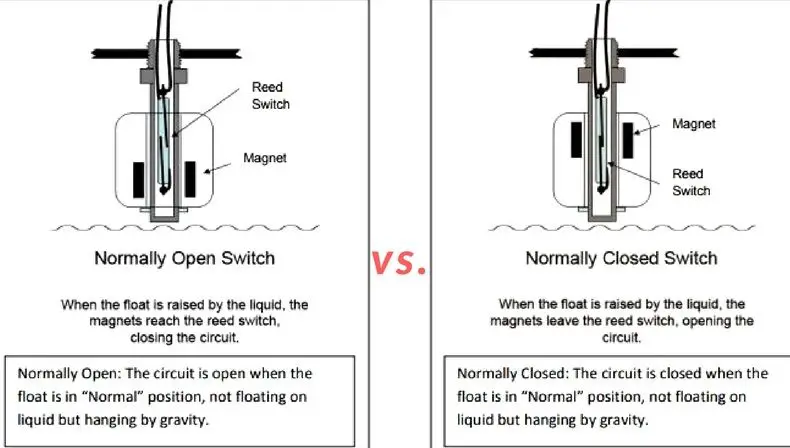A float switch is a device used to detect the level of liquid in a tank or other container. It works by using a float that rises and falls with the liquid level. This float is connected to an electrical switch which is triggered when the float reaches a certain height. Float switches are commonly used in many industrial and residential applications to control the liquid level in tanks and reservoirs. Some example applications include:
- Sump pumps – To automatically turn the pump on and off at certain water levels
- Cooling towers – To maintain the water level by controlling the supply valve
- Septic tanks – To trigger an alarm if the tank starts to overflow
- Irrigation systems – To automatically refill ponds or tanks when the water drops below a set level
- Plumbing systems – To prevent overflow in cisterns and roof tanks
If a float switch fails, it can have serious consequences depending on the particular application. Here are some of the common things that can happen if a float switch stops working properly:
Page Contents
Sump Pump Failure
In sump pump systems, the float switch turns on the pump when water in the sump pit rises to a preset level. If the float switch gets stuck in the on position, it will cause the pump to run continuously. This can lead to the pump overheating and failing prematurely. It also results in unnecessary power consumption and wear on the pump.
If the float switch fails in the off position, the sump pump will not turn on automatically when water accumulates. This can lead to flooding in the basement or crawlspace if the water rises too high before the problem is noticed and the pump is turned on manually.
Cooling Tower Overflow
Float switches in cooling tower applications control the makeup water valve to maintain the proper water level in the cooling tower basin. If the switch fails, the water level can drop too low or overflow.
If the switch gets stuck closed, the makeup valve will remain open and cause the basin to overflow. This wasteful water overflow can lead to unnecessary water usage and flooding around the cooling tower. An overflowing cooling tower basin can also cause extensive corrosion damage over time.
Conversely, if the switch fails closed, the makeup valve will stay closed and not add water even when the level drops too low. Insufficient water in the cooling tower will lead to poor heat transfer and the tower becoming ineffective. This can cause the equipment being cooled by the tower to overheat.
Septic Tank Backup
Float switches in septic tanks turn on an alarm or warning light when the water level gets too high. If the float switch fails, it will not provide the warning of an impending wastewater backup.
Without this warning, the high wastewater level can go unnoticed until sewage backs up into the building’s drain pipes and toilets. This extremely unhygienic sewage backup often leads to costly repairs and restoration work to clean flooded areas.
Irrigation System Malfunction
Float valves maintain proper water levels in ponds, tanks and other reservoirs in irrigation systems. If the float switch sticks shut, the water inlet will remain open and cause the reservoir or tank to overflow. This can lead to flooding, water damage and erosion around the irrigation system.
If the float switch fails closed, it will not allow refilling when the tank water level drops too low. This will disable the irrigation system from being able to draw water for distribution. Crops and landscaping can be severely damaged from lack of water if the issue is not resolved promptly.
Plumbing System Damage
In residential and commercial plumbing systems, float switches prevent roof tanks and cisterns from overflowing. A stuck closed float will let the water level rise uncontrollably until it overflows the tank. The resulting water damage can be severe enough to cause a roof collapse in some cases.
If the float switch fails open, it will not refill the tank when the water level drops too low. This will cut off the water supply to the building’s plumbing system. Lack of water can lead to malfunction of toilets, faucets, washing machines and other water-based appliances.
How to Prevent Float Switch Failure
While float switches can suddenly fail without warning, there are some things that can be done to minimize problems:
- Use float switches rated for the appropriate environment – Industrial float switches are constructed to withstand corrosion,高温, and other hazards.
- Install switches according to manufacturer instructions – Improper installation can lead to switch malfunction.
- Use uninterruptable power supplies (UPS) – Prevent power surges from damaging switches.
- Install alarms and overflow protection – Alarms alert users to issues before major overflow incidents.
- Have qualified personnel perform periodic inspections – Catch mounting problems before failure occurs.
- Replace per manufacturer recommendations – Switches do wear out over time.
What to Do if Failure Occurs
If a float switch does fail, here are some steps to take:
- Shut off power to the malfunctioning equipment if possible.
- Close isolation valves to stop uncontrolled liquid flow.
- Turn on backup pumps or take other steps to mitigate immediate damage.
- Inspect and troubleshoot to determine failure cause.
- Test or replace switch to restore normal operation.
- Cleanup any spills or overflow.
- Repair damages and take steps to prevent recurrence.
Conclusion
Float switches play a vital role in monitoring liquid levels in many important systems and applications. Failure of these devices can lead to equipment damage,水淹, erosion, unhygienic sewage backups and other problems. To minimize issues, proper installation, maintenance and testing of float switches is crucial.
When failures do occur, it is imperative to act swiftly to mitigate immediate damage and restore normal operation. With proper precautions and response planning, serious problems from a malfunctioning float switch can usually be avoided.
